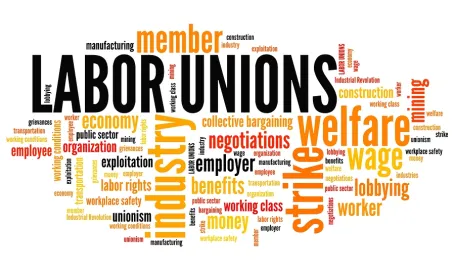On December 18, 2019, the National Labor Relations Board (NLRB) published final rules that will take effect April 16, 2020, changing and clarifying many of the procedures established in the 2014 amendments to the representation case procedures.
Part one of this two-part series provided a detailed analysis of the 2019 rules covering employers’ voter list obligations, requirements regarding the timing of pre-election hearings, the obligation to file a statement of position prior to a pre-election hearing, requirements for communicating the notice of petition, and pre-election hearings to resolve disputes regarding the scope of the unit, voter eligibility, and supervisor status.
Part two of this series covers the introduction of evidence and post-hearing briefs, the scheduling of elections, the effects of a request for review, and election procedures.
Section 102.66—Introduction of Evidence and Post-Hearing Briefs
Consistent with the changes to the pre-election hearing rules, Section 102.66(a) is modified to make clear that parties have the right to call, examine, and cross-examine witnesses, and to present evidence, for all properly raised issues. The rule providing for an Offer of Proof remains intact but cannot be used to preclude a party from introducing evidence at the pre-election hearing.
The 2014 amendments eliminated a party’s right to file a post-hearing brief following a pre-election hearing and required “special permission” from the regional director for a brief to be filed. The 2019 rules restore a party’s right to file a post-hearing brief following a pre-election hearing and has extended this right to post-election hearings as well. Briefs must be submitted within five business days of the close of the hearing. The hearing officer may extend the filing deadline up to 10 additional business days for good cause. Briefs are not required, and the parties may waive the time for filing post-hearing briefs and argue their respective positions orally. Rejecting the rationale of the 2014 amendments that post-hearing briefs often present redundant issues for which briefing is not required and only delay the issuance of a direction of election, the Board recognized that even the most common issues, like independent contractor or supervisory status, turn on detailed factual analysis applied to multi-factor tests contained in the Act and established by Board law.
Section 102.67—Scheduling of an Election and Effects of a Request for Review
A. Issuance of Election Details
The 2014 amendments provided that the regional director “ordinarily” would include election details with the issuance of the decision and direction of election. The pre-2014 rules did not specify when election details should issue, but the common practice was to resolve these details through consultation with the parties. The 2019 rules modify the applicable language to clarify that the regional director “may” specify the election details in the direction of election but retains the discretion to continue the investigation for the election details and issue a Notice of Election after directing an election. This change allows the region additional time to confirm the election details with the parties.
B. Timing for Conducting an Election
The 2019 amendments continue to require the regional director to schedule an election at the earliest date possible, but they restrict the regional director from scheduling an election before the 20th business day following the direction of election unless the parties agree to an earlier date. This primary impetus for this modification is to allow the Board to rule upon most requests for review prior the election and eliminate post-election litigation or the setting aside of election results for elections completed before the Board’s ruling issues. Finally, by defining the timeframe in which an election can be scheduled provides for uniformity in implementation and better establishes what is meant by the “earliest date practicable” within the Board’s procedures. All parties now are aware that there exists a “finite minimum period of time between the direction and conduct of the election.”
C. Pre-Election Requests for Review and Impounding of Ballots
The 2014 amendments eliminated the requirement that the regional director impound all ballots pending the Board’s decision on a request for review. The 2019 rules partially restore the impounding of ballots. When a request for review of a direction of election is filed within 10 business days of the direction of election, the ballots of affected voters will be segregated and all other ballots will be impounded if the Board has not ruled on the request or if the request is granted prior to the conclusion of the election. A party may file a request for review more than 10 business days following the direction of election as provided in the rules, but the pendency of this request will not require the impounding of ballots.
In addition, a regional director no longer will certify election results while a request for review is pending or before the time for seeking review has lapsed. This change will prevent any bargaining obligation from triggering where the granting of the request for review could nullify the certification of the election results.
D. Replies to Oppositions
The Board’s rules permit parties to file oppositions to requests for review, although the Board is not required to wait for such a filing before issuing a ruling. The Board’s rules do not provide for reply briefs responding to briefs in opposition. The Board historically has rejected such reply briefs on grounds that the Board’s procedures do not permit them, but it occasionally has accepted them for good reason. The 2019 amendments codify this long-standing practice by providing that “no reply to the opposition may be filed except upon special leave of the Board.”
Section 102.69—Election Procedures
The 2019 rules make multiple modifications to this section to conform to the changes and modifications discussed above. One modification in this section unrelated to the items discussed above is a clarification regarding election observers. The 2019 rules clarify that each party should select a current member of the voting unit to serve as an observer. A party may select a non-union, non-supervisory employee to serve as an observer only if a member of the voting unit is not available.
The 2019 rules also clarify when a regional director should issue the certification of election results. The regional director may issue the certification of election results after the time for filing a request for review has passed without a request being filed. When a request for review is filed, the certification will issue only after the Board ruling on the request.
Conclusions and Observations
The 2019 rules certainly are more employer friendly than the 2014 amendments and restore some of the fundamental procedures governing representation elections. The more defined timelines contained in the 2019 rules soften the “quickie” timelines of the 2014 amendments and provide for the resolution of important voter eligibility issues before a direction of election. Without rescinding the 2014 amendments, the 2019 rules level the playing field for the conduct of fundamentally fair representation elections. The lengthy explanation justifying the 2019 rules and Member McFerran’s equally lengthy dissent, however, indicate that the Board’s representation procedures will likely remain under scrutiny each time the makeup of the Board majority changes.
Employers are likely to welcome the rule changes and clarifications and may want to consider the practical effects of the revised rules:
-
The 2019 rules return substantial discretion to regional directors particularly with respect to ruling on requests to postpone pre-election hearing and filing deadlines. There is no way to predict how regional directors might exercise this discretion or how far they might depart from the time frames to which they have become accustomed following implementation of the 2014 amendments. Employers, therefore, may want to think twice before relying on regional directors to exercise discretion to deviate from the “new normal” created under the 2014 amendments.
-
The additional time for the filing and service of the voter list is helpful, but employers still may want to consider assessing their preparedness to provide the information to be included on the voter list. The most challenging aspect of the list requirements arises where employees are not required to provide personal information (e.g., email addresses, cell phone numbers) to human resources, but provide this information to their supervisor to facilitate communication on work-related issues such as overtime or changes to work schedules or locations. Employers, therefore, may want to confirm whether supervisors collect this personal contact information. If so, then employers may want to design a mechanism to record or quickly gather the information in case the employer needs to prepare a voter list.
-
The restoration of the requirement to resolve issues of unit scope, voter eligibility, and supervisory status through a pre-election hearing might increase the likelihood that such hearings will occur. Employers, therefore, may want to review job descriptions and actual work performed by individuals whose status might be litigated. The importance of being prepared to argue these issues cannot be overlooked because the 2019 rules still require the filing of a Statement of Position identifying the issues for litigation and the employer’s position on these issues. Although the 2019 rules build in some additional time before the pre-election hearing commences, the time by when the employer’s Statement of Position must be filed and served is not as greatly extended.
-
In anticipation that employers are more likely to proceed to a pre-election hearing to resolve issues of unit scope, voter eligibility, and supervisory status, employers may want to identify who will provide the necessary testimony at the hearing on these subjects. Important factors in such preparation include identifying and preserving documents and other evidence that might be needed for a hearing.
-
The increased time for filing and service of the employer’s Statement of Position is helpful, but in practice may not be as generous as perceived. The 2019 rules retain the requirements of what must be included in the Statement of Position, including a list of the full names, work locations, shifts, and job classifications of all individuals in the proposed unit as of the payroll period preceding the filing of the petition who remain employed at the time of filing. If the employer contends that the proposed unit is inappropriate, the employer is required to separately list the full names, work locations, shifts, and job classifications of all individuals that the employer contends must be added to the proposed unit to make it an appropriate unit. The employer also must identify those individuals, if any, whom it believes must be excluded from the proposed unit. Although the rules allow a regional director to permit a revision to the employer’s Statement of Position for good cause, there is no guarantee that an employer will have the ability to modify an initial filing.
Overall, the 2019 rules may reduce some of the stresses employers have experienced since the 2014 amendments, but only time will tell how the implementation of the 2019 rules will affect the processing of election petitions. Employers can celebrate the return of the requirement to resolve unit scope, voter eligibility, and supervisory status issues through a pre-election hearing rather than deferring these important questions to post-election procedures. The increased timeframes provide some additional relief to pressures arising after receipt of a petition, but many of the onerous requirements imposed by the 2014 amendments remain intact.




 />i
/>i

